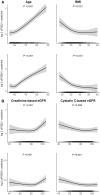Urinary Prostaglandin E2 Excretion and the Risk of Cardiovascular and Kidney Disease
- PMID: 38362883
- PMCID: PMC11010119
- DOI: 10.1161/JAHA.123.032835
Urinary Prostaglandin E2 Excretion and the Risk of Cardiovascular and Kidney Disease
Abstract
Background: Inhibition of prostaglandin synthesis by nonsteroidal anti-inflammatory drugs is associated with cardiovascular mortality and kidney disease. This study hypothesizes that urinary prostaglandin E2 (PGE2) and PGE2 metabolite (PGEM) excretions are markers of cardiovascular and kidney health, because they reflect both systemic and kidney-derived PGE2 production.
Methods and results: PGE2 and PGEM were measured in spot urine samples from 2291 participants (≥55 years old) of the population-based Rotterdam Study. Urinary PGE2 and PGEM excretions were analyzed using linear regression analyses to identify cross-sectional associations with cardiovascular risk factors and baseline estimated glomerular filtration rate (eGFR). Longitudinal associations with cardiovascular mortality and kidney outcomes (eGFR <60 or <45 mL/min per 1.73 m2 and the composite outcome 40% eGFR loss or kidney failure) were assessed with Cox regression. Urinary PGE2 and PGEM excretions were higher with increasing age, lower eGFR, smoking, diabetes, and albuminuria. A 2-fold higher urinary PGE2 and PGEM excretion was associated with a higher risk of cardiovascular mortality (28 825 patient-years; 160 events; PGE2 hazard ratio [HR], 1.27, [95% CI, 1.06-1.54]; PGEM HR, 1.36 [95% CI, 1.10-1.67]). Higher PGE2 excretions were also associated with a higher risk of incident eGFR <60 mL/min per 1.73 m2 (31 530 person-years; 691 events; HR, 1.13 [95% CI, 1.02-1.25]) with similar HRs for the other kidney outcomes.
Conclusions: Urinary PGE2 and PGEM excretions are novel markers for the presence and progression of cardiovascular and kidney disease. Future studies should address whether these associations are causal and can be targeted to improve cardiovascular and kidney outcomes.
Keywords: cardiovascular disease; chronic kidney disease; prostaglandin E2.
Figures




References
-
- Zhang MZ, Wang S, Wang Y, Zhang Y, Ming Hao C, Harris RC. Renal medullary interstitial COX‐2 (cyclooxygenase‐2) is essential in preventing salt‐sensitive hypertension and maintaining renal inner medulla/papilla structural integrity. Hypertension. 2018;72:1172–1179. doi: 10.1161/HYPERTENSIONAHA.118.11694 - DOI - PMC - PubMed
MeSH terms
Substances
LinkOut - more resources
Full Text Sources
Medical
Research Materials
Miscellaneous

